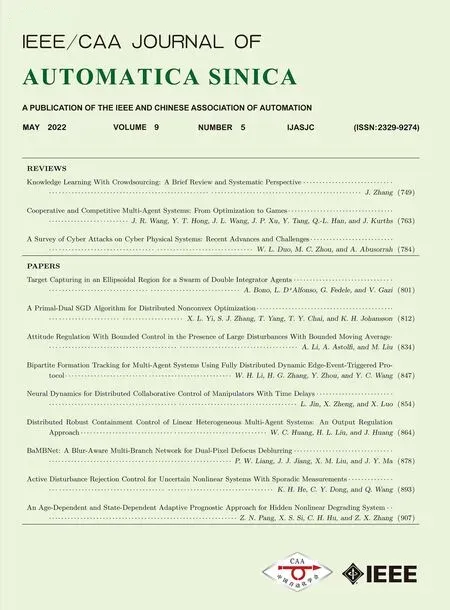Consensus Control for Multiple Euler-Lagrange Systems Based on High-Order Disturbance Observer:An Event-Triggered Approach
Xinchen Guo, Guoliang Wei, Meng Yao, and Pengju Zhang
Dear editor,
This letter addresses the leader-following consensus problem(LFCP) for multiple Euler-Lagrange (EL) systems with a directed topology. Firstly, a local high-order disturbance observer (HODO) is put forward to estimate the compound disturbance for each EL system itself, and the estimate error can ultimately achieve zero.Based on this HODO, an event-based distributed sliding mode control protocol is proposed to solve the LFCP of multiple EL systems. Furthermore, the reachability of the sliding mode surface is analyzed. Besides, it should be pointed out that the interval between any two triggering instants is a strictly positive value, hence the wellknown Zeno behavior is avoided for the developed event-based protocol. Finally, the effectiveness of the proposed HODO and control protocol is further verified by a numerical simulation.
Related work: The collective behavior of multi-agent systems has been widely applied to many engineering fields, such as intelligent robots, traffic control, as well as sensor networks ([1]?[10]), since its advantages of high efficiency and high fault tolerance. Meanwhile, as a kind of typical collective behavior, distributed cooperative control is one of the hottest research topics. Specially, it can be divided into the following several cases: consensus control, formation control and containment control (see [11]?[13]).
In recent years, multi-agent systems with EL dynamics have received ever-increasing research attention (see [4], [5]) due mainly to the superiority of modeling some typical actual industrial systems,such as multi-arm robots, mobile robots and spacecraft. Notably, the control protocols designed in the above papers need the assumption of continuous communication, which may require sufficient computing resources and an ideal communication environment.However, in practical engineering applications, agents have limited communication bandwidth and on-board energy, so that the above requirements cannot be achieved. Therefore, an event-triggered method is introduced to solve this problem. Specially, for multiple EL systems, two event-triggered strategies, i.e., decentralized and distributed, have been developed in [6] with the help of Barbalat’s Lemma. Furthermore, the event-based containment control has been studied in [7] over directed networks. Recently, the same issue has also been investigated in [8], where an event-based observer is proposed to estimate the trajectory inside the convex hull spanned by the leaders’ states.
It should be pointed out that, the multi-agent system with EL dynamics has more strong uncertainty and nonlinearity.Unfortunately, the methods used in general linear and nonlinear systems cannot be directly extended to this kind of multi-agent system. As an alternative approach, a disturbance observer (DO) can be employed to estimate the uncertainties consisting of both unmodeled dynamics as well as some external disturbances [14]. In order to improve the observation performance, an HODO has been proposed in [15], and subsequently applied to estimate the mismatched disturbance for a class of underactuated robotic system in [16], under which it has been shown that the higher the order of the disturbance observer, the smaller the norm of the observer error.
As far as the authors know, lots of developed results of multi-agent systems with EL dynamics are based on some simplification on system models, such as the case without uncertain parameters,gravity vector or unknown external disturbances. However, all these cases could occur in practical engineering, which results in an urgent requirement of developing a more general control protocol based on event-triggering communication. In addition, the sliding mode control strategy proposed in this letter can effectively recompense the uncertain parameters and external disturbances of the EL system, of which the algorithm is simple and response speed is fast. Thence, it is more convenient for practical engineering applications. Inspired by the above-mentioned problems, this letter is devoted to studying the LFCP for multiple EL systems over a directed topology. The main contributions are as follows.
● A local HODO is designed to estimate the compound disturbance(including uncertain parameters and external disturbance) of EL systems, and the observer gain matrices are selected to make the observer error ultimately approaches zero.
● An event-based distributed sliding mode control strategy is proposed to handle the LFCP of multiple EL systems in order to reduce the updating frequency and save energy. In addition, by designing an appropriate triggering function, it can be proved that there is no infinite number of triggering events within a finite time.


● A local HODO is proposed to estimate the compound disturbance of EL systems, where the observer error ultimately approaches zero;

Fig. 1. Schematic of the proposed event-based control strategy.



Fig. 2. Communication topology of one leader and four followers.


Fig. 3. Estimate error and trajectory of disturbance observer.
Conclusions: The LFCP for multiple EL systems has been addressed in this letter. Firstly, a local HODO is designed to observe the compound disturbance of each EL system. Based on the HODO,an event-based distributed sliding mode controller is proposed to solve the LFCP for multiple EL systems. Furthermore, we prove that each EL system with the event-triggered scheme excludes the famous Zeno behavior in any finite operation time interval. Finally, the simulation results of two-link robot arms system show the effectiveness of the proposed observer and controller. Our future work will focus on the finite-time and fixed-time consensus of multiple EL systems.
Acknowledgments: This work was supported by the National Natural Science Foundation of China (61873169).

Fig. 4. Position tracking errors and velocity tracking errors.

Fig. 5. Triggering times during the time interval [ 0, 100 s].
 IEEE/CAA Journal of Automatica Sinica2022年5期
IEEE/CAA Journal of Automatica Sinica2022年5期
- IEEE/CAA Journal of Automatica Sinica的其它文章
- Attitude Regulation With Bounded Control in the Presence of Large Disturbances With Bounded Moving Average
- A Primal-Dual SGD Algorithm for Distributed Nonconvex Optimization
- Knowledge Learning With Crowdsourcing:A Brief Review and Systematic Perspective
- Target Capturing in an Ellipsoidal Region for a Swarm of Double Integrator Agents
- A Survey of Cyber Attacks on Cyber Physical Systems: Recent Advances and Challenges
- Recursive Fault Estimation With Energy Harvesting Sensors and Uniform Quantization Effects
